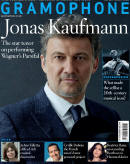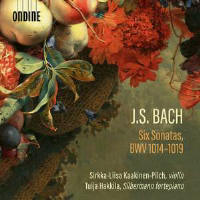Texte paru dans: / Appeared in: |
|
|
|
|
|
This album of Bach’s Six Sonatas, BWV1014-19, is accompanied by a lengthy and excellently detailed note from Bach scholar David Yearsley. We learn that the composer’s second son, CPE Bach, sent a letter to Johann Nikolaus Forkel in 1774 that referred to the collection as ‘6 Clavier Trios’ – and claimed them as among the best works of his ‘dear departed father’ (‘des seeligen lieben Vaters’). CPE also had a copy made by Johann Friedrich Hering, which lists the obbligato harpsichord (‘Cembalo concertato’) above the violin (‘Violono solo’) on the title-page. This text also accords with that on the front of the surviving copy most closely linked to the composer (one penned by JS’s nephew and student Johann Heinrich Bach in the mid-1720s). Given all this historical evidence that these were sonatas composed for violin and harpsichord, why then perform them on violin and fortepiano (in this case, a copy of a Gottfried Silbermann fortepiano from 1747)?
Though a reason is not exactly spelt out in a personal statement from baroque violinist Sirkka-Liisa Kaakinen-Pilch or keyboard player Tuija Hakkila, Yearsley’s note continues to offer some plausible historical reasons. There are moments when the choice of fortepiano works wonders: it sparkles in the concluding Presto of the Sonata in A and somehow makes the contrapuntal exchange even more joyous. In the solo keyboard movement of the Sonata in G, an Allegro, Hakkila conjures a cheeky chappie who moves between mischief and reluctant labour (though greater rhythmic integrity would enhance this characterisation even further).
But there are also movements where, for me, the fortepiano really doesn’t work. Take, for example, the second movement of the Sonata in B minor. The fortepiano clutters the texture; Hakkila’s rather heavy touch and occasional delay in responding in counterpoint doesn’t help the cause, either. I detest the effect used in the Adagio ma non tanto of the Sonata in E. This music is quite touching enough, thank you – no tricks or gadgets are needed. A slightly steadier tempo, too, might help in achieving a more heartfelt breath and line.
For the most part, I am very taken by Kaakinen-Pilch’s confident and imaginative playing. There’s lovely ornamentation and shaping in the Largo of the Sonata in C minor, and the opening to the Allegro finale of the E major is utterly fabulous, exploding in visceral energy. However, I wonder whether a more harmonic approach towards intonation would lift these performances; KaakinenPilch tends towards melodic tuning, and the occasional effect is a sweetness that lacks emotional depth. |
|




